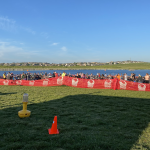
Discover the Power of Forward Lean for Improved Running
Running is a popular form of exercise and a great way to stay in shape. However, to get the most out of your runs, it’s important to pay attention to your posture and technique. One key aspect of good running form is the forward lean. In this article, we’ll explore the science behind forward lean, how to implement it, and the benefits it can bring to your running performance.
One thing I will stress in this discussion is the need to lift the pelvis bones up and forward when aiming to achieve the proper lean (trunk angle). The forward lean component of proper run gait has been repeatedly discussed in peer reviewed research from the scientific standpoint (Folland, et al. 2017, Haghighat, 2021, Gaudette, 2022) and what is commonly discussed in the coaching community and my own experience is a forward lean around 4-10 degrees. As in anything in sports and biomechanics there is individual variation. My rule of thumb is a goal of roughly 8 degrees based on consistency in research the past couple of decades and what I have seen in the field over that same time span while coaching all athlete ability levels.
Why is forward lean so important? First it adds the component of gravity to assist in forward movement. Second proper forward lean assists in correct foot to ground contact placement, and thirdly forward lean while maintaining proper hip/pelvis alignment will allow for an open run stride.
To illustrate this latter point to athletes during coaching sessions, I describe the marathon shuffle. As one observes a marathon we can witness a change in run gait as the marathon time increases. One of the aspects observed in those runners with longer marathon times is these athlete will have an increased bend at the hips in their run gait form compared to faster athletes. This decreases the stride length, decreasing economy and speed at a given effort level. As the athlete fatigues over the marathon, the athletes bend at the hips more, decreasing the stride length and the athlete slows down even more. We are then witnessing a downward spiral in run form and thus further decreases in speed as the marathon progresses. For this reason, if you have ever observed me coaching on a course be it a youth triathlon, standard distance triathlon, marathon, or Ironman, you have heard me screaming, “hips up and forward!” on the run course.
To summarize, your goal as a runner is to have a trunk angle of around 8 degrees while paying attention that your pelvic bones are lifted up and forward. Furthermore, think of your ears, shoulders, hips, and side of your ankle in a straight line while running.
As the weather warms up, most of you are in a window for dialing in your running form. Take advantage of a special discount for Race Omaha athletes from Petersen Performance Lab. Get a 10 percent discount or 15 percent discount for those who prepay with minimum four months coaching leading up to a Race Omaha race. Please email coachbrett@petersenperformancelab.com or call 312-388-4021 for more information.










